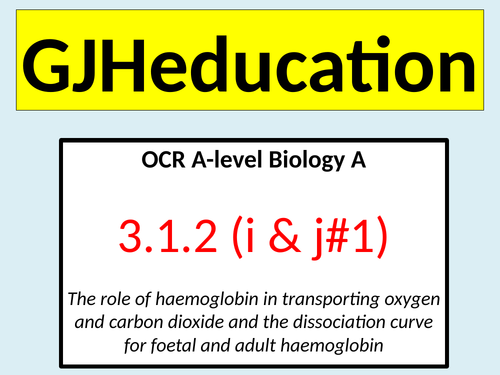

This engaging lesson looks at the role of haemoglobin in transporting oxygen and carbon dioxide and compares the dissociation curves for foetal and adult haemoglobin. The detailed PowerPoint has been designed to cover points 3.1.2 (i & j) of the OCR A-level Biology A specification and includes references to the role of carbonic anhydrase and the formation of haemoglobinic acid and carbaminohaemoglobin.
The lesson begins with a version of the quiz show Pointless to introduce haemotology as the study of the blood conditions. Students are told that haemoglobin has a quaternary structure and are challenged to use their prior knowledge of biological molecules to determine what this means for the protein. They will learn that each of the 4 polypeptide chains contains a haem group with an iron ion attached and that it is this group which has a high affinity for oxygen. Time is taken to discuss how this protein must be able to load (and unload) oxygen as well as transport the molecules to the respiring tissues. Students will plot the oxyhaemoglobin dissociation curve and the S-shaped curve is used to encourage discussions about the ease with which haemoglobin loads each molecule. At this point, foetal haemoglobin and its differing affinity of oxygen is introduced and students are challenged to predict whether this affinity will be higher or lower than adult haemoglobin and to represent this on their dissociation curve.
The remainder of the lesson looks at the different ways that carbon dioxide is transported around the body that involve haemoglobin. Time is taken to look at the dissociation of carbonic acid into hydrogen ions so that students can understand how this will affect the affinity of haemoglobin for oxygen in an upcoming lesson on the Bohr effect.
It is estimated that it will take in excess of 2 hours of A-level teaching time to cover the detail of these two specification points as covered in this lesson
Get this resource as part of a bundle and save up to 44%
A bundle is a package of resources grouped together to teach a particular topic, or a series of lessons, in one place.
Module 3: Exchange and transport (OCR A-level Biology A)
This bundle contains 18 detailed and engaging lessons which cover the following specification points in module 3 (Exchange and transport) of the OCR A-level Biology A specification: 3.1.1: Exchange surfaces * The need for specialised exchange surfaces * The features of an efficient exchange surface * The structures and functions of the components of the mammalian gaseous exchange system * The mechanism of ventilation in mammals * The mechanisms of ventilation and gas exchange in bony fish and insects 3.1.2: Transport in animals * The double, closed circulatory system in mammals * The structure and functions of arteries, arterioles, capillaries, venules and veins * The formation of tissue fluid from plasma * The external and internal structure of the heart * The cardiac cycle * How heart action is initiated and coordinated * The use and interpretation of ECG traces * The role of haemoglobin in transporting oxygen and carbon dioxide * The oxygen dissociation curve for foetal and adult haemoglobin 3.1.3: Transport in plants * The structure and function of the vascular systems in the roots, stems and leaves * The transport of water into the plant, through the plant and to the air surrounding the leaves * The mechanism of translocation As well as the detailed A-level Biology content of the PowerPoint slides, the resources contain a wide range of tasks including guided discussion points, exam-style questions and quiz competitions which will engage and motivate the students
Module 3.1.2: Transport in animals (OCR A-level Biology)
Each of the 9 lessons in this bundle are fully-resourced and have been designed to cover the content as detailed in module 3.1.2 (Transport in animals) of the OCR A-Level Biology A specification. The specification points that are covered within these lessons include: * A double, closed circulatory system * The structure and function of arteries, arterioles, capillaries, venules and veins * The formation of tissue fluid from plasma * The internal and external structure of the mammalian heart * The cardiac cycle * How heart action is initiated and coordinated * The use and interpretation of ECGs * The role of haemoglobin in transporting oxygen and carbon dioxide * The dissociation curve for foetal and adult haemoglobin * The Bohr effect The lessons have been written to include a wide range of activities and numerous understanding and prior knowledge checks so students can assess their progress against the current topic as well as be challenged to make links to other topics within this topic and earlier topics If you would like to see the quality of the lessons, download the formation of tissue fluid. heart action and ECGs lessons as these are free
Something went wrong, please try again later.
This resource hasn't been reviewed yet
To ensure quality for our reviews, only customers who have purchased this resource can review it
Report this resourceto let us know if it violates our terms and conditions.
Our customer service team will review your report and will be in touch.